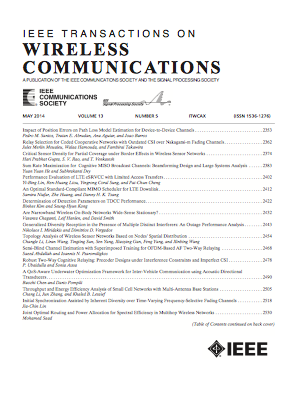RISnet:面向互耦合和部分CSI的RIS优化的领域知识驱动神经网络体系结构
IF 10.7
1区 计算机科学
Q1 ENGINEERING, ELECTRICAL & ELECTRONIC
引用次数: 0
摘要
空分多址(SDMA)在现代无线通信中发挥着重要作用。它的性能取决于通道特性,这可以通过可重构智能表面(RISs)来改善。在这项工作中,我们共同优化了基站(BS)和RIS配置的SDMA预编码。我们解决了RIS元素之间相互耦合的困难,可扩展到1000多个RIS元素,以及对信道估计的高要求。首先推导了一个考虑互耦合的RIS辅助信道模型,然后提出了一种无监督机器学习(ML)方法,利用专用神经网络(NN)结构RISnet对RIS进行优化,该结构具有良好的可扩展性、良好的置换不变性和较低的信道估计要求。此外,我们利用现有的高性能分析预编码方案,提出了一种基于ml的RIS配置和BS分析预编码的混合解决方案。更一般地说,这项工作是将机器学习技术和领域知识结合起来用于神经网络架构设计的早期贡献。与通用机器学习相比,特定问题机器学习可以实现更高的性能、更低的复杂性和排列不变性。本文章由计算机程序翻译,如有差异,请以英文原文为准。
RISnet: A Domain-Knowledge Driven Neural Network Architecture for RIS Optimization With Mutual Coupling and Partial CSI
space-division multiple access (SDMA) plays an important role in modern wireless communications. Its performance depends on the channel properties, which can be improved by reconfigurable intelligent surfaces (RISs). In this work, we jointly optimize SDMA precoding at the base station (BS) and RIS configuration. We tackle difficulties of mutual coupling between RIS elements, scalability to more than 1000 RIS elements, and high requirement for channel estimation. We first derive an RIS-assisted channel model considering mutual coupling, then propose an unsupervised machine learning (ML) approach to optimize the RIS with a dedicated neural network (NN) architecture RISnet, which has good scalability, desired permutation-invariance, and a low requirement for channel estimation. Moreover, we leverage existing high-performance analytical precoding scheme to propose a hybrid solution of ML-enabled RIS configuration and analytical precoding at BS. More generally, this work is an early contribution to combine ML technique and domain knowledge in communication for NN architecture design. Compared to generic ML, the problem-specific ML can achieve higher performance, lower complexity and permutation-invariance.
求助全文
通过发布文献求助,成功后即可免费获取论文全文。
去求助
来源期刊
CiteScore
18.60
自引率
10.60%
发文量
708
审稿时长
5.6 months
期刊介绍:
The IEEE Transactions on Wireless Communications is a prestigious publication that showcases cutting-edge advancements in wireless communications. It welcomes both theoretical and practical contributions in various areas. The scope of the Transactions encompasses a wide range of topics, including modulation and coding, detection and estimation, propagation and channel characterization, and diversity techniques. The journal also emphasizes the physical and link layer communication aspects of network architectures and protocols.
The journal is open to papers on specific topics or non-traditional topics related to specific application areas. This includes simulation tools and methodologies, orthogonal frequency division multiplexing, MIMO systems, and wireless over optical technologies.
Overall, the IEEE Transactions on Wireless Communications serves as a platform for high-quality manuscripts that push the boundaries of wireless communications and contribute to advancements in the field.

 求助内容:
求助内容: 应助结果提醒方式:
应助结果提醒方式:


